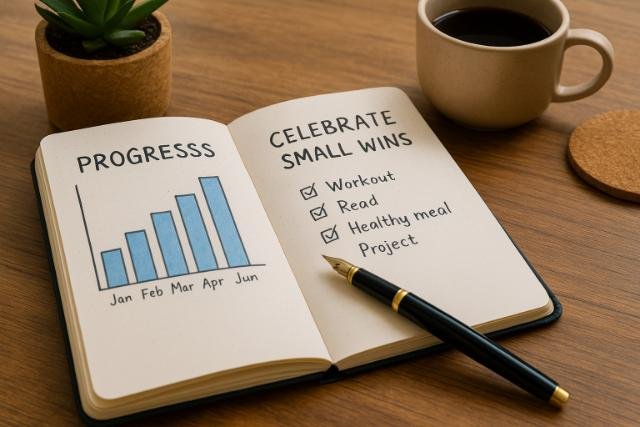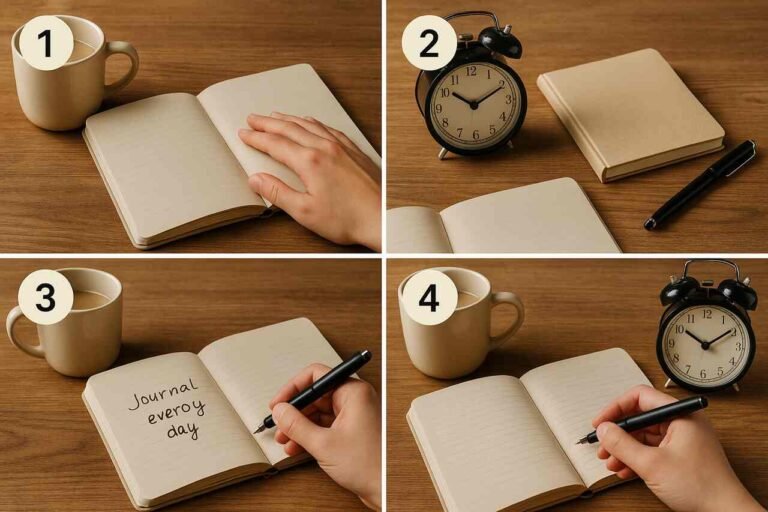Introduction
Building a journaling habit is one of the most rewarding personal growth practices you can adopt. It enhances self-awareness, reduces stress, sharpens focus, and promotes emotional clarity. However, creating a consistent habit can be challenging without the right structure and mindset. This step-by-step guide explains practical methods, tools, and psychological techniques that help you establish journaling as a lasting daily routine. Whether you are new to journaling or looking to rekindle a lost habit, this guide offers an actionable roadmap for success.
Define Your Journaling Purpose
A strong journaling habit begins with understanding why you want to write. Defining your purpose helps anchor your motivation and gives meaning to every entry. Some journal to manage emotions, others to plan goals, track gratitude, or enhance creativity. By identifying your reason, you transform journaling from a random activity into a purposeful daily ritual.
Your purpose influences the style and format of your journal. For instance, a gratitude journal focuses on appreciation, a bullet journal organizes tasks, and a reflective journal explores emotions. Clarify what kind of self-improvement or awareness you seek through your practice. This ensures every session aligns with your emotional and mental objectives.
In the long term, a defined purpose fosters consistency. When you have a clear “why,” skipping a day feels like missing an important conversation with yourself. This intrinsic motivation makes journaling sustainable and personally rewarding.
Identify Core Motivations
Ask yourself what outcome you want from journaling such as emotional release, productivity, self-reflection, or creativity. Write these motivations at the front of your journal to keep them visible and inspiring.
Choose the Right Journal Type
Select a journal that fits your intent. A gratitude notebook for positivity, a planner for organization, or a reflective diary for personal growth. The physical or digital format should enhance your comfort and consistency.
Select the Right Tools and Environment
Choosing the correct tools and setting plays a crucial role in developing a journaling habit. A comfortable writing space reduces distractions, while the right tools make the process enjoyable. Consider whether you prefer handwriting in a notebook or typing in a digital app.
Your environment should be peaceful and inviting. A desk near a window, a cozy chair, or even a quiet corner can become your creative sanctuary. Keep your journal and pen easily accessible to minimize barriers between intention and action.
Consistency thrives in a space that feels safe and inspiring. Personalize your environment with small rituals such as lighting a candle or playing soft music to trigger a journaling mindset. Over time, these cues create a conditioned response that signals your brain to focus.
Choose Between Digital and Physical Journals
Digital journals like Notion or Day One offer convenience and searchability. Physical journals, however, promote mindfulness through the tactile act of writing. Choose based on your lifestyle and comfort.
Design a Distraction-Free Zone
Establish a dedicated spot for journaling. Silence notifications, declutter your area, and ensure adequate lighting. A well-organized environment encourages deeper reflection and creativity.
Establish a Realistic Schedule
Consistency is the backbone of habit formation. To make journaling stick, start small and build gradually. Choose a time of day when you are least likely to be interrupted such as early morning or before bed. The goal is to associate journaling with a specific moment in your daily routine.
You do not need to write pages at once. Even five minutes of focused journaling can yield benefits. The key is regularity, not volume. Over time, your brain begins to expect and crave this ritual of reflection and expression.
By setting realistic goals, you reduce the likelihood of burnout. Sustainable habits grow through small, manageable actions repeated consistently.
Find Your Ideal Time of Day
Morning journaling promotes goal-setting and focus. Evening journaling aids reflection and emotional processing. Experiment to discover when you feel most mentally open and engaged.
Use Habit Triggers
Link journaling to an existing routine such as after coffee, before bed, or post-workout. Triggers create automatic reminders that integrate the habit seamlessly into your life.
Start with Simple Prompts and Structures
Beginners often struggle with what to write. Using prompts or templates provides structure and removes the pressure of perfection. Start with simple reflections like “What made me smile today?” or “What did I learn from today’s challenge?”
Structured journaling frameworks such as the Five-Minute Journal or Bullet Journal Method are excellent starting points. They balance creativity with organization, helping you focus your thoughts efficiently.
As you grow comfortable, evolve your prompts to match your goals. Some days you may want deep reflection, others may focus on gratitude or productivity. Flexibility keeps journaling interesting and relevant.
Explore Journaling Prompts
Create a list of prompts covering gratitude, self-awareness, goals, and emotions. Rotate them weekly to maintain freshness and prevent monotony.
Use Guided Journals and Templates
Guided journals provide pre-set questions and spaces for daily entries, ideal for beginners who prefer structure. They help form a consistent rhythm and reduce writer’s block.
Track Your Progress and Celebrate Small Wins

Tracking your progress strengthens motivation and reinforces your journaling habit. Note the number of days you have written or reflect on improvements in your mood, focus, or productivity. Visual tracking such as checklists or habit trackers makes your progress tangible.
Celebrating milestones creates positive reinforcement. Completing a week or a month of consistent journaling deserves recognition. Rewarding yourself strengthens the psychological association between journaling and satisfaction.
Tracking also helps identify patterns. You may notice that journaling improves emotional balance or clarity. Such insights deepen your self-awareness and reinforce your commitment.
| Tracking Method | Description | Benefits |
| Habit Tracker | Calendar or app marking each journaling day | Visual motivation |
| Reflection Log | Summarize weekly insights | Identifies growth trends |
| Mood Tracker | Rate daily emotions alongside entries | Links journaling to wellbeing |
Use a Visual Habit Tracker
Use calendars or bullet journal grids to mark each day you write. Seeing your streak grow increases accountability and commitment.
Reward Yourself for Consistency
Celebrate progress with small rewards such as a favorite treat, a new pen, or a relaxing break. Positive reinforcement makes the habit enjoyable.
Overcome Common Journaling Challenges

Every habit faces obstacles, and journaling is no exception. The most common barriers include time constraints, self-criticism, and lack of inspiration. Recognizing these challenges helps you respond effectively rather than give up.
If you feel stuck, reduce expectations. Write a few sentences instead of pages. Remember, the goal is consistency, not perfection. Missed days do not erase progress. Simply restart the next day without guilt.
Understanding your psychological triggers also helps. Journaling should be freeing, not stressful. Treat it as a personal conversation rather than a performance.
Manage Time and Motivation
Set short writing sessions of five to ten minutes daily. Even minimal effort maintains continuity and prevents overwhelm.
Combat Perfectionism
Accept imperfection as part of growth. Focus on authenticity over grammar or aesthetics. Your journal is for expression, not evaluation.
Deepen and Personalize Your Journaling Practice
Once journaling becomes a regular habit, you can personalize it to reflect deeper emotional and intellectual growth. Explore advanced techniques like stream-of-consciousness writing, goal visualization, or gratitude mapping. Each method enhances self-awareness from different perspectives.
Personalization involves integrating other elements such as drawings, affirmations, or quotes. You can also use journaling to set intentions, track progress toward long-term goals, or document meaningful life events.
Ultimately, a journaling habit evolves into a personal development system. It helps you monitor emotions, refine goals, and cultivate mindfulness, making it not just a habit but a lifestyle.
Experiment with Journaling Styles
Try bullet journaling, morning pages, or gratitude logs. Mixing formats keeps the practice engaging and aligned with evolving needs.
Reflect and Adjust Regularly
Review previous entries monthly. Evaluate emotional patterns and achievements, then refine your approach for deeper insight and growth.
Conclusion
Building a journaling habit is a gradual journey of self-discovery, discipline, and emotional growth. By defining your purpose, choosing the right tools, setting realistic schedules, and celebrating progress, you create a system that enriches your life daily. Journaling transforms fleeting thoughts into meaningful insights, helping you understand yourself better and live with greater clarity. Consistency, compassion, and curiosity are your best allies in this transformative habit.
Explore more insightful and valuable content on our blog journalingtechniques! Stay updated with helpful tips, expert advice, and in-depth articles that enhance your knowledge.
FAQ’s
Start with 5 to 10 minutes daily. The goal is consistency rather than duration. Over time, your sessions will naturally extend as journaling becomes part of your routine.
Missing a day does not mean failure. Resume the next day without guilt. Habit-building thrives on persistence, not perfection.
Choose based on your comfort. Paper journals enhance mindfulness through handwriting, while digital tools offer convenience and searchability.
Use prompts or lists to spark ideas. Even writing a few words about your current mood helps maintain momentum.
Yes. Expressive writing reduces stress by releasing emotions and clarifying thoughts. It also promotes emotional resilience and mindfulness.
Many people feel clarity and calm after the first week. Long-term benefits such as improved focus and self-awareness develop over consistent months of practice.

